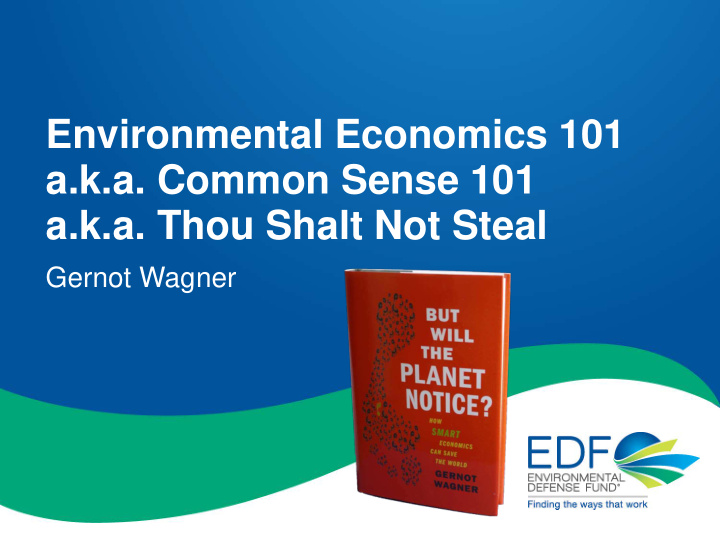



Environmental Economics 101 a.k.a. Common Sense 101 a.k.a. Thou Shalt Not Steal Gernot Wagner
Would you choose the standard or hybrid version?
The “rational” view of car-buying behavior You walk into a dealership, choose a car based on brand, color, cylinders, looks and general feel and then start comparing prices among different options. You also look at gas mileage, today’s price per gallon, form an opinion about future gas price trends, attach probabilities to them, calculate expected total gas costs over the lifetime of the car, balance all of that information against expectations over future inflation rates and interest paid were you to just leave your money in the bank, take into account how your preferences for driving will evolve over time, make a few assumptions about how future buyers will perceive your choice when you are ready to sell the car, and do all that (and probably a few things I’m missing), while the car salesman at the dealership explains to you the awesome industry-leading warranty and zero-down loan program offered through the end of the month… As if…
Car buyers are “70% rational” in most traditional, standard economic sense For every $1 in fuel savings later, car buyers spend $0.72 more today Source: Allcott & Wozny (2011)
WHY CAP AND TRADE Flexibility on several dimensions • “Who” flexibility – trading among emitters • “What” flexibility – trading among different sectors of the economy and among different greenhouse gases • “Where” flexibility – credits for rigorously verified emissions offsets from agriculture and forestry — including tropical forest nations • “When” flexibility – allowance banking and borrowing More flexibility means lower overall costs.
A bit of economic jargon: Externalities • A negative externality occurs when one economic agent indirectly and unintentionally imposes a cost on another. – Second-hand smoke – Auto insurance – Air and water pollution • In the absence of regulation, the damages from air pollution are “external” to individual factories or power plants – i.e., not included in costs or profits
What’s the solution? • From an economic perspective, the problem is one of “missing markets” – A factory pays for the costs of labor, capital, materials, etc., but not for the costs associated with its pollution • The key role of government is to correct the incentives facing individuals and firms – “Get the prices right” – Force firms to internalize the costs of their actions
Environmental Economics 101 a.k.a. “Common Sense 101” Privatizing benefits, socializing costs leads to fish dying, aquifers drying up, the globe warming. The solution: privatize benefits and privatize costs
1.5%
30 : 1
EPA tops benefit-cost comparison across agencies Source: OMB’s “2011 Report to Congress on the Benefits and Costs of Federal Regulations”
Once you put capital to work, jobs are created. Michael Morris CEO, American Electric Power
Federal carbon reduction policies Criteria E m i s s i o n s E c o n o m i c s E q u i t y effectiveness Social equity within sector* Potential for reductions in reallocation Reductions Innovation Coverage reductions Flexibility economy* certainty certainty Potential Potential Cost Cost- Cap & Trade High Cap & = = Medium Dividend Policies Carbon tax = = Low Gas Tax >> Transport ~25% Clean Energy 70% 60% Power Standards Feed-In Tariffs 70% 60% Power Harnessing Cross- private capital 20-50% 20-50% sector EPA power 20% Power 20% regulations Fuel economy 600%** Transport 25% standards * Relative to covered Waxman-Markey emissions reduction targets of 42% below 2005 baseline by 2030. ** Road transport emissions increase under Waxman-Markey by 2030.
Gernot Wagner gwagner@edf.org gwagner.com
Recommend
More recommend